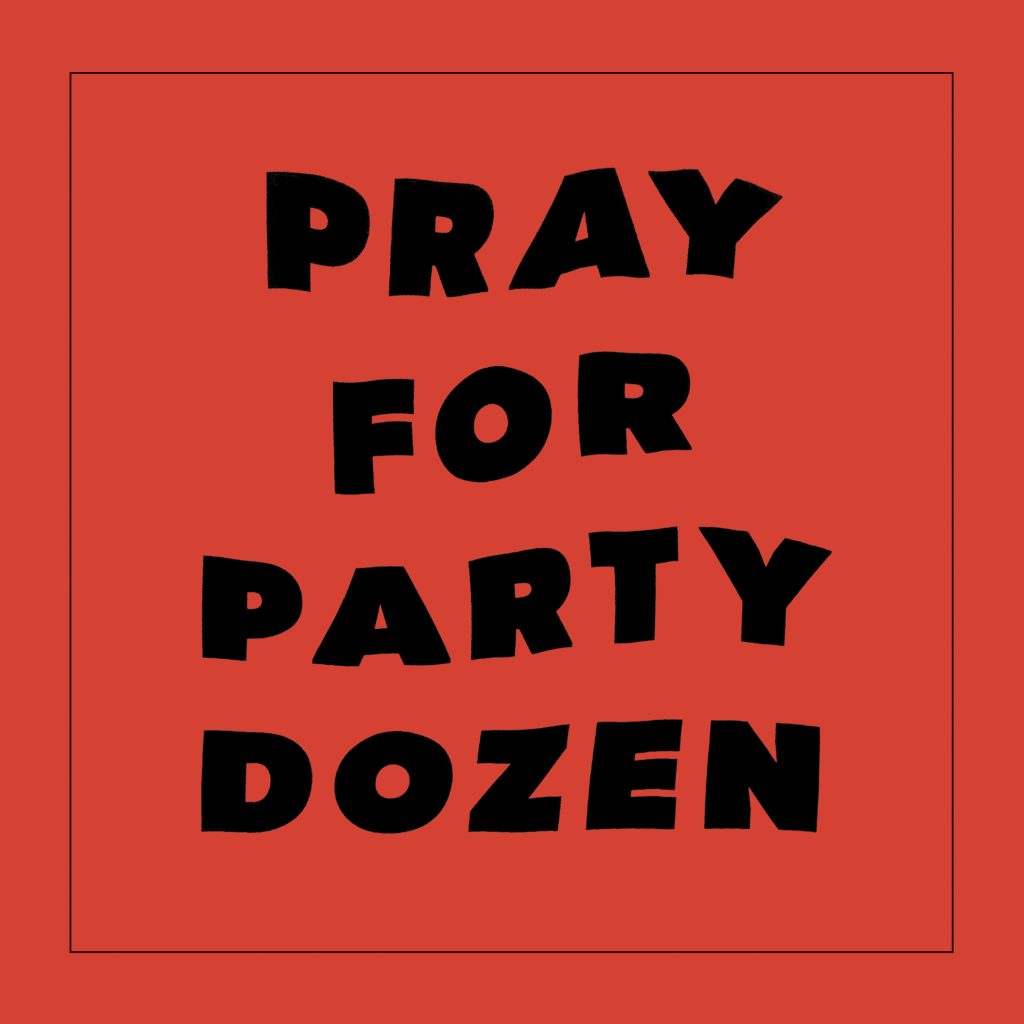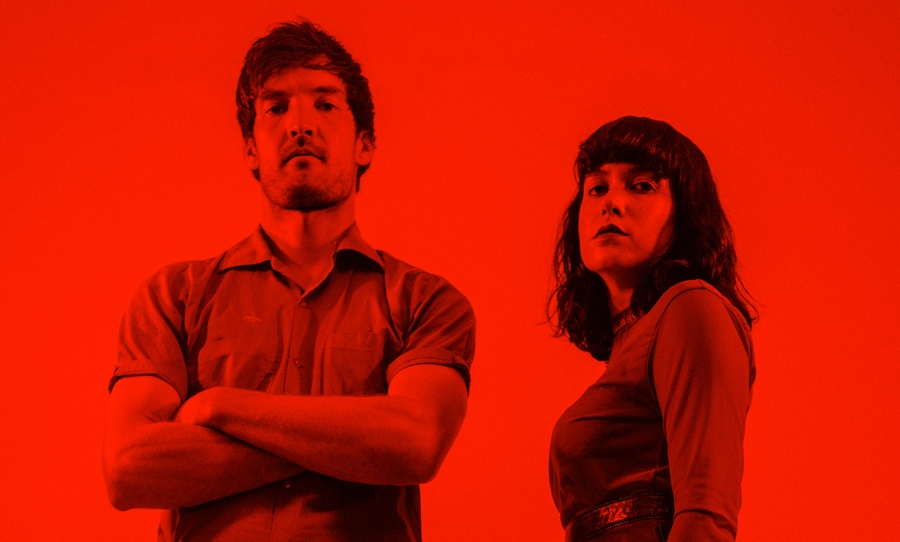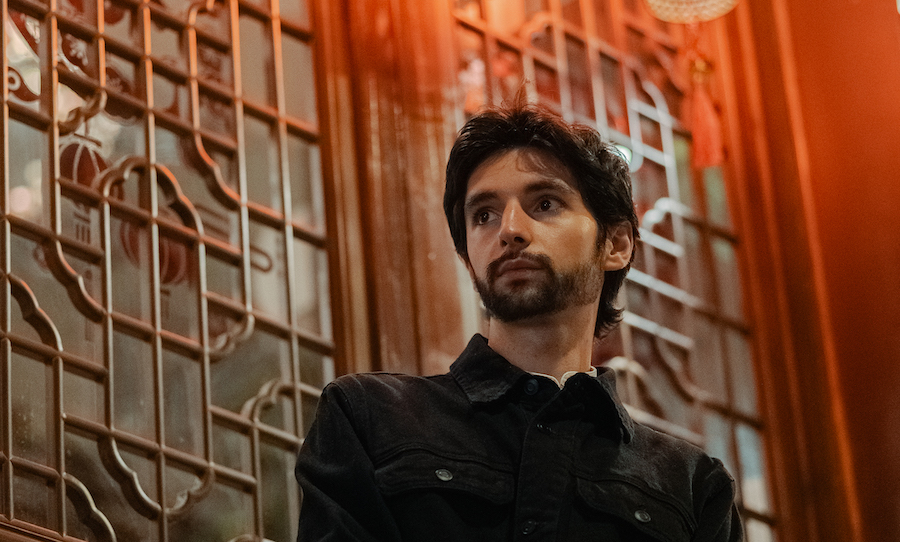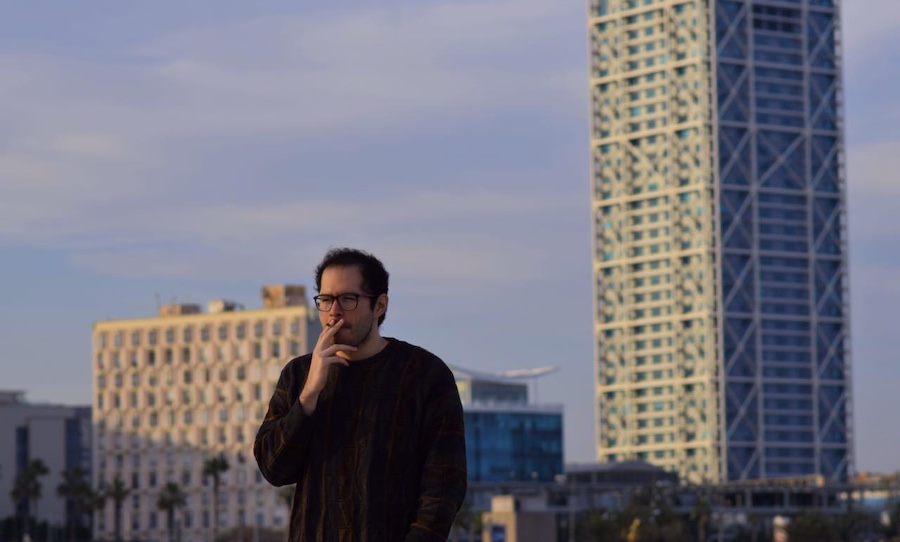Almost three years on from their debut album Living Man, Party Dozen have returned to the stage in the way that only Party Dozen can.
As bold and unforgiving as ever, their latest album Pray For Party Dozen demonstrates a flexing of the band’s muscles, exploring greater depths and a wider sonic colour palette that previously seen. Wrapped up in cultish imagery, the mostly instrumental album pushes the boundaries and seeks pleasure in the extreme.

Champions of abstract emotion, on their second album, Pray For Party Dozen, Party Dozen stretch their thrilling sensibilities to new realms.
For Party Dozen, making albums is about capturing a spectrum. The project of saxophonist Kirsty Tickle and percussionist Jonathan Boulet, Party Dozen is based fundamentally on improvisation. Speaking with us ahead of the album release, Boulet described how he likes to think of the making a record in terms of colours: “We want as many colours as we can have on a record. If you can condense that to ten or so tracks, there’s enough space to be different but it’s also not too short.”
If you think of the album in terms of colours, manic album opener World Prayer is probably white. White noise. It’s a track which perhaps harks back most to its predecessor, an instant hit of maniacal saxophone lines and frantic drum rolls. Listening to World Prayer is like gazing into the abyss. The song alternates between moments of pure chaos and dizzying respite, before abruptly screeching to a halt.
Speaking in an interview with Tone Deaf, the band describe the track as the “least palatable” of the album, recalling how it is also the most demanding to play, the recording process leaving them both shaking and sweating. Tickle and Boulet have acknowledged there is an end-point to the desire to be the loudest, fastest, craziest band around. Their sights have shifted now. This album saw them trying to push dynamics, tempos, and instrumentation, whilst still retaining the same ethos. “We wanted to make it a touch more listenable than the last one, while still experimenting,” Boulet described to us.
Yet whilst the band worried that this shift might leave the record too sprawling (“[It’s] harder to sequence the record, because you’ve got opposite ends of the spectrum. It’s hard to go from some hectic noise song into something really tender,” Boulet told us), it seems this spectrum of extremes works deeply in their favour.
Following on from World Prayer is The Great Ape – one of the album’s greatest gems, recently picked up by Henry Rollins and played on his KCRW show. Slower than some of their previous work, sludgy drums carve out space beneath long, drawn-out saxophone notes that wail with existential pain. The addition of guitar adds a welcome element and the song ends with a series of cinematic hits. It’s stadium rock, but for the apocalypse.
The album takes a turn with the titular Party Dozen – named as such because it so perfectly embodies the spirit of the band – a blistering industrial track punctuated by synth gurks and distorted saxophone screeches. This world is expanded on the (albeit slower) Auto-Loser where the marriage of pulsing, chromatic synth bass loops and heady dance beats makes for one of the most exciting offerings on the album. We’ve well and truly entered the steely alloy of the cyber-punk landscape now. More stripped-back than some of their other work, the track really enables the duo to shine. Of course, without the moments of pure chaos, songs like Auto-Loser might not be so utterly pleasing – proving that it’s within the dynamic of extremes that Party Dozen best harness their power.
“Auto Loser is about the person that’s already lost,” the band described to Tone Deaf. “They lost before they began. Everything sucks, everybody stinks. They’ve tried nothing and they’re all out of ideas.” For a mostly instrumental album, it’s nice to get an insight into the meaning behind the music. And more so, it’s that kind of brazen certainty that lies at the heart of what makes Party Dozen so powerful. It’s an outlet to say I am what I am – and that’s a very punk thing to say.
For Tickle and Boulet, part of capturing these different moods is spreading out the recording process so as to avoid everything sounding too similar. Built on organ-like synth chords, Dead Friends certainly moves away from the monochromatism of Auto-Loser to offer something more melancholic and blue, even sprinkled with vague elements of jazz.
The band have described how the track was inspired by a conversation between Tickle and Boulet where they morbidly reflected on the fact that not many of their friends had suffered untimely deaths. Always anchored by the repeated synth chords and bass line, the fatalistic track is torn between two emotions – anxious anticipation and inevitable acceptance.
On Gun Control we move back towards the chaotic end of the spectrum. The track is ushered in with Kirsty’s fuzzy vocals, screeching with feedback as she sings into her saxophone bell – the same technique used on Dead Friends and later again on Scheisse Kunst. The song is then overtaken by doomy, fuzz-filled low saxophone lines and thrashing drums.
The longest track on the album, Play the Truth, is a kind of intersection between the band’s slower, more melody-driven sensibilities and their faster, more chaotic moments. Clocking in at just under 6 minutes, the solemn track blends ’70s influences with something increasingly deranged as it builds with breathtaking scope, all the while propelled by ceremonial, twangy guitar strums.
The band have described how the album, along with its imagery was inspired by cults. If any track were to fit in with the cult imagery it would be this one – as well as The PDD, which the band satirically describe as a pivotal moment in their fictional history, where they “became less friendly and started to enforce our values”; a time known as “the reign of The PDD.”
Yet if Party Dozen is a cult, what is the object of its worship? Like most good punk music it heralds only an attitude: be whatever you want, just don’t be a dick.

Scheisse Kunst takes things back in the electronic, stripped-down direction, and sounds somewhat like the more menacing cousin of Auto-Loser, driven by a similarly chromatic baseline which feels like the melodic inverse the former.
Yet just as much as the album is about colour, it’s about emotion. Perhaps they are two sides of the same coin. Boulet has described that Pray For Party Dozen was an album more about “vibes than genres”, built on things that made him and Tickle feel certain ways. Champions of abstract feeling, listening to the album is a truly sensory experience.
The spectrum of Pray For Party Dozen is perhaps no more apparent than when reaching its end, where Dirty Three-inspired album closer Shit Faced provides a more introspective turn. If the album in its entirety acts a kind of ritual cleansing, this is surely the final step – a last respite amidst the chaos, or perhaps, just an incentive to start all over again.
Pray For Party Dozen is out now, grab your copy here.



